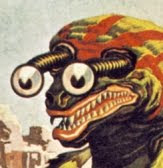

It's surprising how many articles, as opposed to stories, I end up reading in these 1920s Strands. There are few fewer non-fiction articles in the 20s copies when compared with the pre-war editions but since most of them are about writers and writing, I find more of them interesting. In the April 1927 issue I found an article which amused me - modern art being put on trial. A traditionalist slags off modern art he doesn't appreciate by the likes of Paul Klee, and then a well-known at the time art critic defends them.
Sensibly, the latter didn't bother to defend each picture in detail, he just pointed out how work 'now' appreciated and valuable had been hated in the past for the same reasons - it was new and different. He quoted two examples: the first of these was written in the press in response to a collection of Van Gogh, when his work was frst seen in England in 1911:
'(The works) showed intellectual, emotional and techincal degeneracy, wilful anarchy and notoriety-hunting, which, if it were not transparent, might be compared with ciminality... For a moment there even came a fierce feeling of terror lest the youth of England, young promising fellows, might be contaminated here...
'It would be nauseating to myself and your readers to dwell on details. It would be almost as unpleasant to read as to see. There is no fear for permanent mischief, I hope. The thing is too bad for that. There is no regeneration for deluded egoists. They are morally lost in the Inferno where Dante places the unfaithful to God...
'I hope the press will team with resentment aganist the insults offered to the noble arts of Design, Sculpture, and Painting, an insult also, to the taste of the English people. This invasion of depressing rubbish is, thank Heaven, new to our island of sensible and, in their own fashion, poetic people.'
But if you thought that drivel was extraordinary, there now follows what Charles Dickens had to say about Millais' Christ in the Carpenter's Shop when it was first shown at the Royal Academy:
'You behold the interior of a carpenter's shop. In the foreground... is a hideous, wry-necked, blubbering, red-headed boy, in a bed-gown, who appears to have received a poke in the hand from the stick of another boy with whom he has been playing in an adjacent gutter, and to be holding it up for the conetemplation of a kneeling woman so horrible in her ugliness ... she would stand out from the rest of the Company as a Monster in the vilest cabaret in France or the lowest gin-shop in England...
'Whenever it is possible to express ugliness of feature, limb, or attitude, you have it expressed. Such men as the carpenters might be undressed in any hospital where dirty drunkards in a high state of varicose veins are received.
'This, in the 19th century ... is what the Pre-Raphaelite Art can do to render reverence and homage to the faith in which we live and die! We should be certain of the Plague, among other advantages, if this Brotherhood were properly encouraged.'
Dickens also suggested that Millais had sunk to 'the lowest depths of what is mean, odious, repulsive, and revolting' in his painting. It reads like a review of one of the first few punk albums not an attempt to recapture the style of medieval art.
What I found especially illuminating about Dickens's rant is how at odds it is with his heritage of being 'the champion of the poor' - clearly what offended him most was that the Holy Family were being portrayed as poor; humble, human, artisan people. But then the gilding on Dickens' reputation as a humanitarian has tarnished somewhat over the years. I rather feel he shows his true colours in this 'critique'.




No comments:
Post a Comment